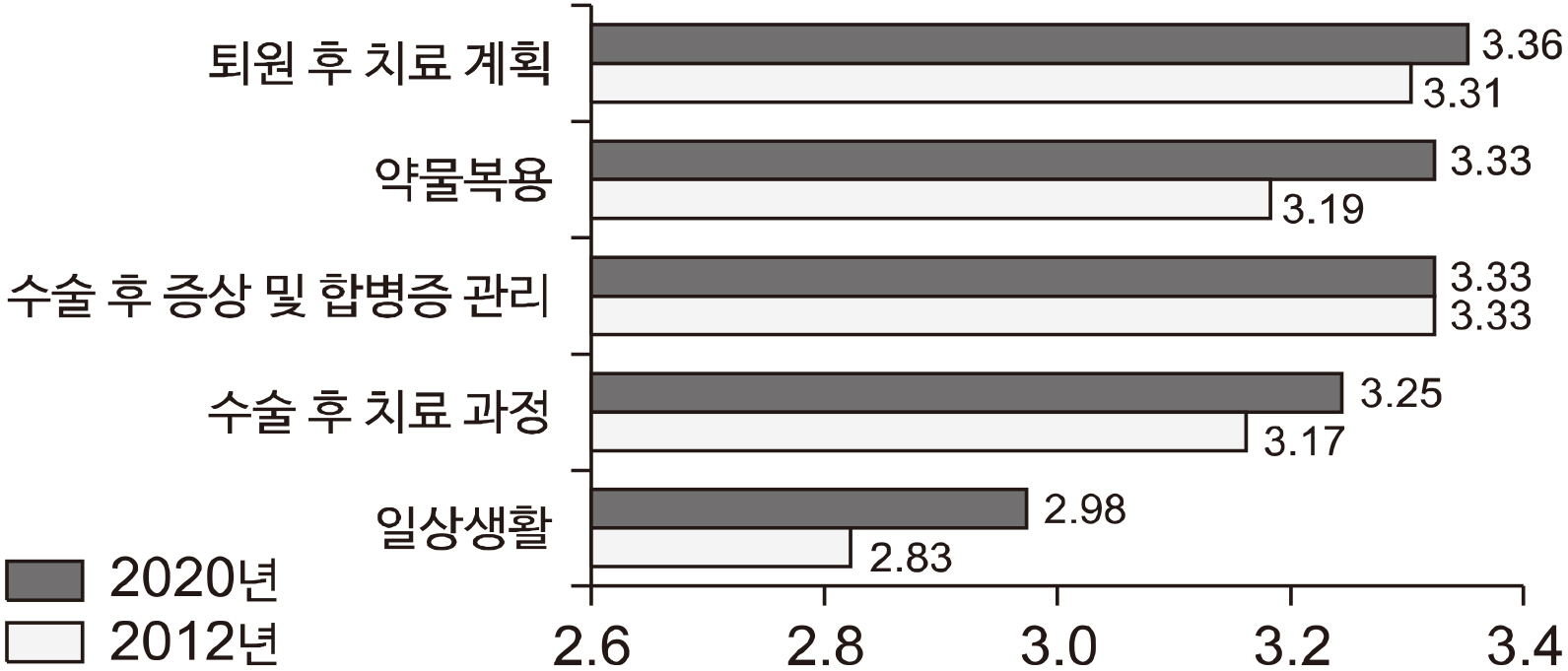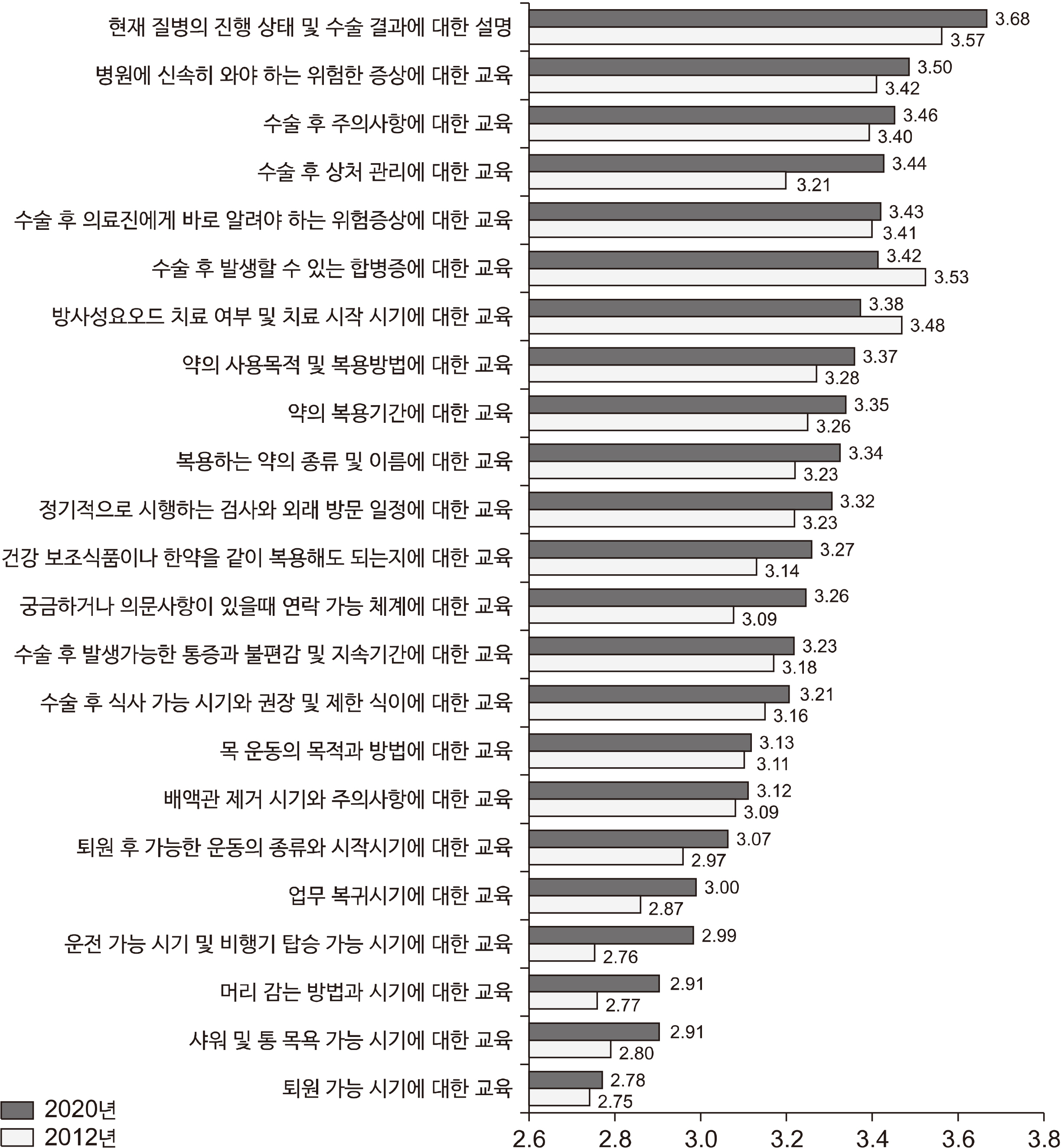Int J Thyroidol.
2022 May;15(1):28-35. 10.11106/ijt.2022.15.1.28.
Changing Trends What Patients with Thyroid Cancer Surgery Are Concerned About: Comparison between 2012 and 2020
- Affiliations
-
- 1Graduate School, Ewha Womans University, Gangnam Severance Hospital, Yonsei University College of Medicine, Seoul, Korea
- 2Thyroid Cancer Center, Gangnam Severance Hospital, Yonsei University College of Medicine, Seoul, Korea
- 3Division of Nursing, Gangnam Severance Hospital, Yonsei University College of Medicine, Seoul, Korea
- 4Department of Surgery, Gangnam Severance Hospital, Yonsei University College of Medicine, Seoul, Korea
- KMID: 2530123
- DOI: http://doi.org/10.11106/ijt.2022.15.1.28
Abstract
- Background and Objectives
Given the major changes in spread of COVID-19 and the contribution of technological innovation, the objective of the current study was to compare the educational needs of thyroid cancer patients between 2012 and 2020.
Materials and Methods
The subject of this study were 159 patients in 2012 and 149 patients in 2020 who underwent thyroid cancer surgery. Data were collected from September 2020 to December 2020. Their responses were compared with response for the 2012 survey. The survey contained 36 questions regarding demographics and 5 areas of educational needs (Treatment plan after discharge, Management of the symptom and the complication after surgery, Medication management, Postoperative wound and dietary management, Daily life).
Results
The most preferred teaching method for thyroid cancer surgery patients has changed from small group education to self-study with videos. The Internet accounted for the largest proportion of source of information and the preferred educator for the patient were doctors and nurses in both 2012 and 2020. ‘Current disease condition and surgical result’ was the highest ranked in both 2012 and 2020.
Conclusion
It is necessary to develop and utilize an educational method using video centered on medical team including doctors and nurses.
Keyword
Figure
Reference
-
References
1. Korea Central Cancer Registry, National Cancer Center. Annual report of cancer statistics in Korea in 2018. Ministry of Health and Welfare;2020.2. Papaleontiou M, Reyes-Gastelum D, Gay BL, Ward KC, Hamilton AS, Hawley ST, et al. 2019; Worry in thyroid cancer survivors with a favorable prognosis. Thyroid. 29(8):1080–8. DOI: 10.1089/thy.2019.0163. PMID: 31232194. PMCID: PMC6707035.
Article3. Jeong HC. 2008; The effect of in-patient guide movie and booklet programs on understanding of hospital life and satisfaction with the programs. J Korean Acad Nurs Adm. 14(1):45–50.4. Park HY. 2020; Pedagogical implications and future prospects of non-contact instruction. Education Review. 46:30–64.5. Kim HJ, Kim DH. 2011; Nursing educational needs for discharge after thyroid cancer surgery: patients vs. nurses. J Korean Acad Soc Nurs Edu. 17(2):287–95. DOI: 10.5977/JKASNE.2011.17.2.287.
Article6. Kim H, Park YH, Oh YJ, Park KA, Kim IS, Woo KM, et al. 2013; What are patients with thyroid cancer surgery concerned about? Int J Thyroidol. 6(2):115–20. DOI: 10.11106/jkta.2013.6.2.115.
Article7. Faul F, Erdfelder E, Lang AG, Buchner A. 2007; G*Power 3: a flexible statistical power analysis program for the social, behavioral, and biomedical sciences. Behav Res Methods. 39(2):175–91. DOI: 10.3758/BF03193146. PMID: 17695343.
Article8. Korea Information Society Development Institute. 2020 broadcasting media user behavior survey. Korea Communications Commission;2020.9. Jung MY, Hong IK, Noh HY, Park HS, Son JM, Kim JH, et al. 2015; Effects of video-based information provision on anxiety and education satisfaction of thyroid cancer patients undergoing radioiodine treatment. Clin Nurs Res. 21:11–20.10. Ay S, Ata N, Oncu F. 2022; Effect of an information video before thyroid biopsy on patients' anxiety. J Invest Surg. 35(3):531–4. DOI: 10.1080/08941939.2021.1882623. PMID: 33557641.
Article11. Kim MK, Kim J. 2018; The effects of educational video program delivered using tablet PC on physical discomfort, uncertainty, state anxiety, and nursing education satisfaction among early gastric cancer patients undergoing endoscopic submucosal dissection. J Korean Clin Nurs Res. 24(2):147–58.12. Ha BY, Lee IS, Jeong SG, Jang CS. 2020; Effect of web-based video self-management education program for infection prevention in patients with cancer receiving chemotherapy: a preliminary study. J Korean Acad Soc Home Care Nurs. 27(3):294–305.13. Roberts KJ, Lepore SJ, Urken ML. 2008; Quality of life after thyroid cancer: an assessment of patient needs and preferences for information and support. J Cancer Educ. 23(3):186–91. DOI: 10.1080/08858190802247762. PMID: 18709591.
Article14. Chang K, Berthelet E, Grubbs E, Hamilton S, Karvat A, Tran E, et al. 2020; Websites, websites everywhere: how thyroid cancer patients use the internet. J Cancer Educ. 35(6):1177–83. DOI: 10.1007/s13187-019-01576-5. PMID: 31332622.
Article15. Starks C, Akkera M, Shalaby M, Munshi R, Toraih E, Lee GS, et al. 2021; Evaluation of YouTube videos as a patient education source for novel surgical techniques in thyroid surgery. Gland Surg. 10(2):697–705. DOI: 10.21037/gs-20-734. PMID: 33708552. PMCID: PMC7944056.
Article16. Chen DW, Reyes-Gastelum D, Hawley ST, Wallner LP, Hamilton AS, Haymart MR. 2021; Unmet information needs among Hispanic women with thyroid cancer. J Clin Endocrinol Metab. 106(7):e2680–e7. DOI: 10.1210/clinem/dgab128. PMID: 33660770. PMCID: PMC8208677.
Article17. Doubleday AR, Novin S, Long KL, Schneider DF, Sippel RS, Pitt SC. 2021; Online information for treatment for low-risk thyroid cancer: assessment of timeliness, content, quality, and readability. J Cancer Educ. 36(4):850–7. DOI: 10.1007/s13187-020-01713-5. PMID: 32108292.
Article18. Chang KL, Grubbs EG, Ingledew PA. 2019; An analysis of the quality of thyroid cancer websites. Endocr Pract. 25(10):1003–11. DOI: 10.4158/EP-2018-0595. PMID: 31170373.
Article19. Udayanga V, Jayarajah U, Colonne SD, Seneviratne SA. 2020; Quality of the patient-oriented information on thyroid cancer in the internet. Health Policy Technol. 9(3):302–7. DOI: 10.1016/j.hlpt.2020.03.007.
Article20. Statistics Korea. 2021. National education level (distribution by educational background) [Internet]. Available from: https://www.index.go.kr/potal/main/EachDtlPageDetail.do?idx_cd=1530. Daejeon: Statistics Korea;cited January 10, 2021.21. Pitt SC, Wendt E, Saucke MC, Voils CI, Orne J, Macdonald CL, et al. 2019; A qualitative analysis of the preoperative needs of patients with papillary thyroid cancer. J Surg Res. 244:324–31. DOI: 10.1016/j.jss.2019.06.072. PMID: 31306889. PMCID: PMC6815701.
Article22. Hopwood P, Fletcher I, Lee A, Al Ghazal S. 2001; A body image scale for use with cancer patients. Eur J Cancer. 37(2):189–97. DOI: 10.1016/S0959-8049(00)00353-1. PMID: 11166145.
Article23. Becker CB, Verzijl CL, Kilpela LS, Wilfred SA, Stewart T. 2019; Body image in adult women: associations with health behaviors, quality of life, and functional impairment. J Health Psychol. 24(11):1536–47. DOI: 10.1177/1359105317710815. PMID: 28810463. PMCID: PMC7091492.
Article
- Full Text Links
- Actions
-
Cited
- CITED
-
- Close
- Share
- Similar articles
-
- Time Trends Analysis of Characteristics of Patients with Thyroid Cancer in a Single Medical Center
- Postoperative Surveillance of Thyroid Cancer: in View of US
- Giant Thyroid Cancer in Elderly Patient
- An Unusual Case of Metastatic Non-Small Cell Lung Cancer Misidentified as Anaplastic Thyroid Cancer
- Best Achievements in Clinical Thyroidology in 2020



